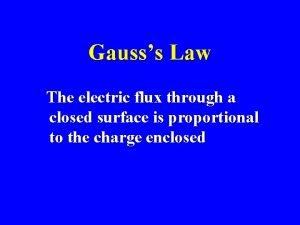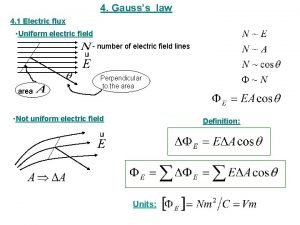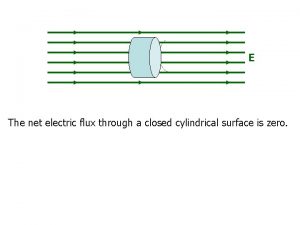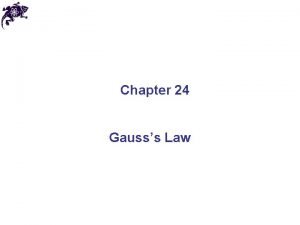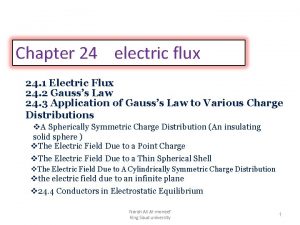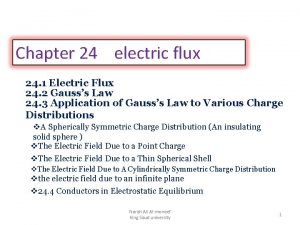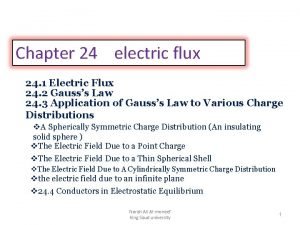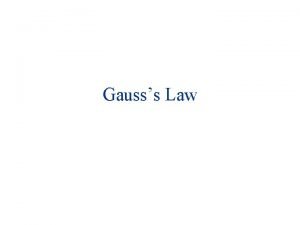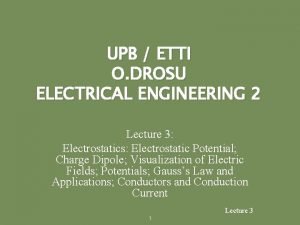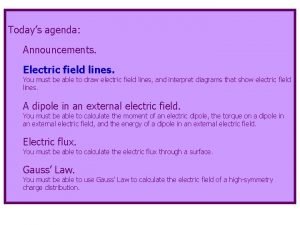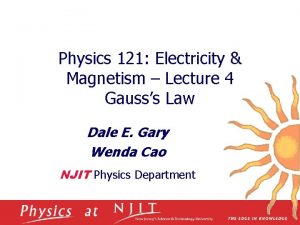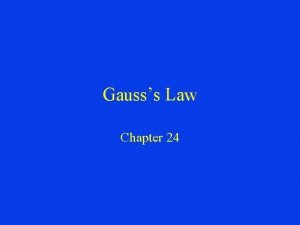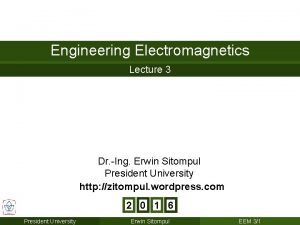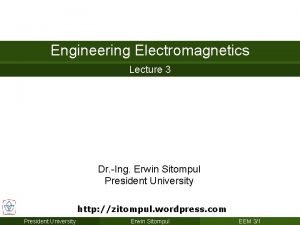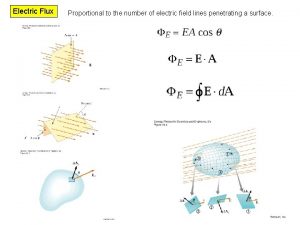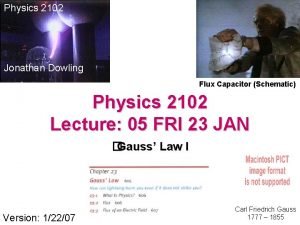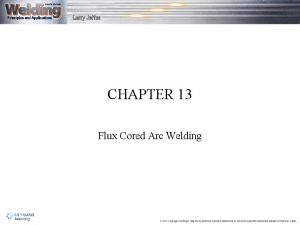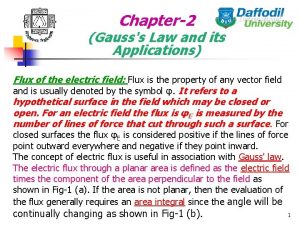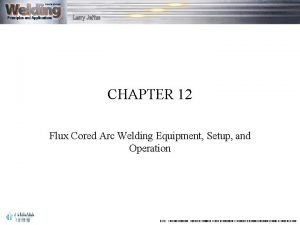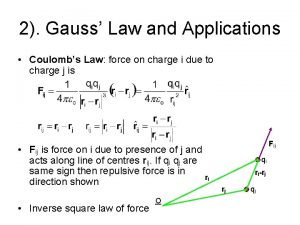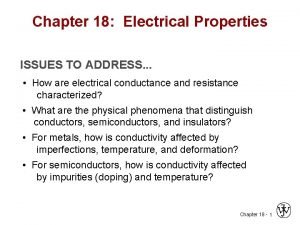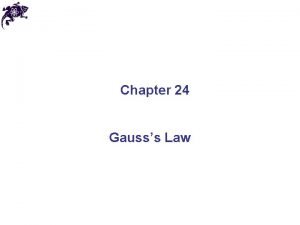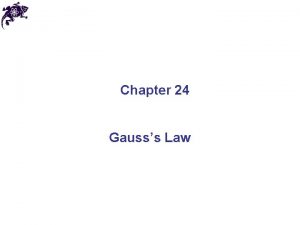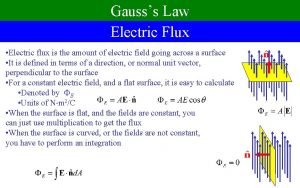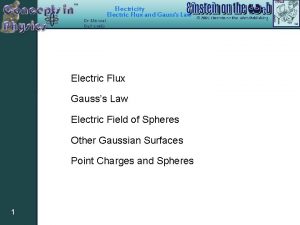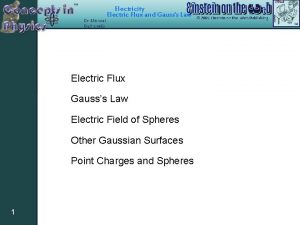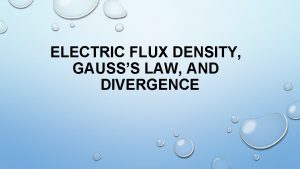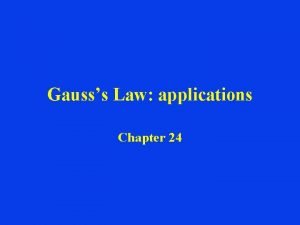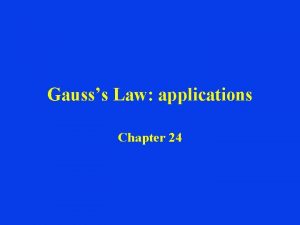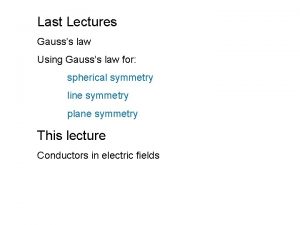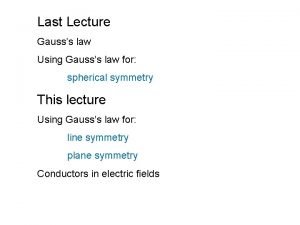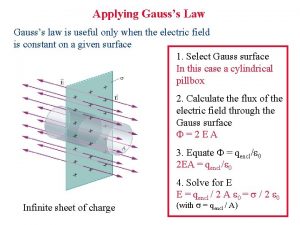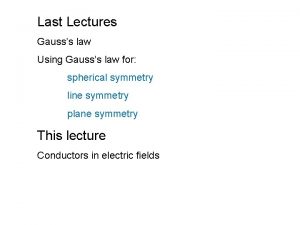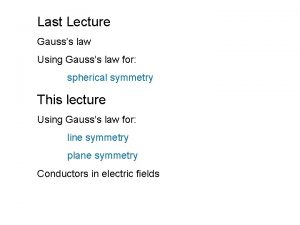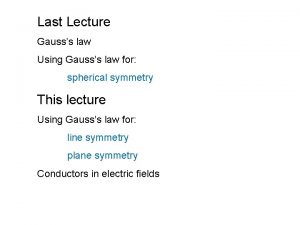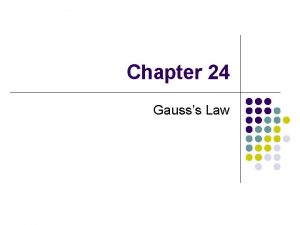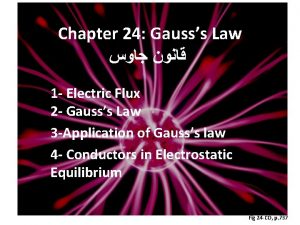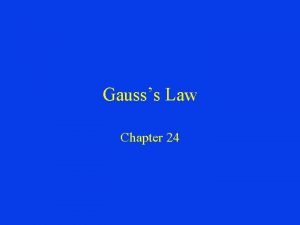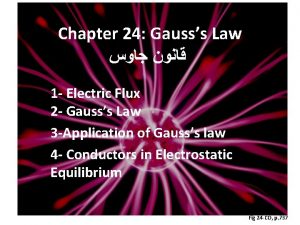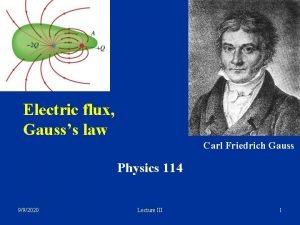Chapter 24 Gausss Law Electric Flux n n






































- Slides: 38

Chapter 24 Gauss’s Law

Electric Flux n n Electric flux is the product of the magnitude of the electric field and the surface area, A, perpendicular to the field ΦE = EA

Electric Flux, General Area n n n The electric flux is proportional to the number of electric field lines penetrating some surface The field lines may make some angle θ with the perpendicular to the surface Then ΦE = EA cos θ

Electric Flux, Interpreting the Equation n The flux is a maximum when the surface is perpendicular to the field The flux is zero when the surface is parallel to the field If the field varies over the surface, Φ = EA cos θ is valid for only a small element of the area

Electric Flux, General n n In the more general case, look at a small area element In general, this becomes

Electric Flux, final n n n The surface integral means the integral must be evaluated over the surface in question In general, the value of the flux will depend both on the field pattern and on the surface The units of electric flux will be N. m 2/C 2

Electric Flux, Closed Surface n n Assume a closed surface The vectors ΔAi point in different directions n n At each point, they are perpendicular to the surface By convention, they point outward

Active Figure 24. 4 (SLIDESHOW MODE ONLY)

Flux Through Closed Surface, cont. n n n At (1), the field lines are crossing the surface from the inside to the outside; θ < 90 o, Φ is positive At (2), the field lines graze surface; θ = 90 o, Φ = 0 At (3), the field lines are crossing the surface from the outside to the inside; 180 o > θ > 90 o, Φ is negative

Flux Through Closed Surface, final n The net flux through the surface is proportional to the net number of lines leaving the surface n n This net number of lines is the number of lines leaving the surface minus the number entering the surface If En is the component of E perpendicular to the surface, then

Gauss’s Law, Introduction n Gauss’s law is an expression of the general relationship between the net electric flux through a closed surface and the charge enclosed by the surface n n The closed surface is often called a gaussian surface Gauss’s law is of fundamental importance in the study of electric fields

Gauss’s Law – General n n A positive point charge, q, is located at the center of a sphere of radius r The magnitude of the electric field everywhere on the surface of the sphere is E = keq / r 2

Gauss’s Law – General, cont. n n n The field lines are directed radially outward and are perpendicular to the surface at every point This will be the net flux through the gaussian surface, the sphere of radius r We know E = keq/r 2 and Asphere = 4πr 2,

Gauss’s Law – General, notes n n n The net flux through any closed surface surrounding a point charge, q, is given by q/εo and is independent of the shape of that surface The net electric flux through a closed surface that surrounds no charge is zero Since the electric field due to many charges is the vector sum of the electric fields produced by the individual charges, the flux through any closed surface can be expressed as

Gauss’s Law – Final n n n Gauss’s law states qin is the net charge inside the surface E represents the electric field at any point on the surface n n E is the total electric field and may have contributions from charges both inside and outside of the surface Although Gauss’s law can, in theory, be solved to find E for any charge configuration, in practice it is limited to symmetric situations

Active Figure 24. 9 (SLIDESHOW MODE ONLY)

Applying Gauss’s Law n n n To use Gauss’s law, you want to choose a gaussian surface over which the surface integral can be simplified and the electric field determined Take advantage of symmetry Remember, the gaussian surface is a surface you choose, it does not have to coincide with a real surface

Conditions for a Gaussian Surface n Try to choose a surface that satisfies one or more of these conditions: n n The value of the electric field can be argued from symmetry to be constant over the surface The dot product of E. d. A can be expressed as a simple algebraic product Ed. A because E and d. A are parallel The dot product is 0 because E and d. A are perpendicular The field can be argued to be zero over the surface

Field Due to a Point Charge n Choose a sphere as the gaussian surface n E is parallel to d. A at each point on the surface

Field Due to a Spherically Symmetric Charge Distribution n n Select a sphere as the gaussian surface For r >a

Spherically Symmetric, cont. n n n Select a sphere as the gaussian surface, r < a qin < Q qin = r (4/3πr 3)

Spherically Symmetric Distribution, final n Inside the sphere, E varies linearly with r n n E → 0 as r → 0 The field outside the sphere is equivalent to that of a point charge located at the center of the sphere

Field Due to a Thin Spherical Shell n n n Use spheres as the gaussian surfaces When r > a, the charge inside the surface is Q and E = ke. Q / r 2 When r < a, the charge inside the surface is 0 and E = 0

Field at a Distance from a Line of Charge n Select a cylindrical charge distribution n n The cylinder has a radius of r and a length of ℓ E is constant in magnitude and perpendicular to the surface at every point on the curved part of the surface

Field Due to a Line of Charge, cont. n n The end view confirms the field is perpendicular to the curved surface The field through the ends of the cylinder is 0 since the field is parallel to these surfaces

Field Due to a Line of Charge, final n Use Gauss’s law to find the field

Field Due to a Plane of Charge n n E must be perpendicular to the plane and must have the same magnitude at all points equidistant from the plane Choose a small cylinder whose axis is perpendicular to the plane for the gaussian surface

Field Due to a Plane of Charge, cont n n E is parallel to the curved surface and there is no contribution to the surface area from this curved part of the cylinder The flux through each end of the cylinder is EA and so the total flux is 2 EA

Field Due to a Plane of Charge, final n n The total charge in the surface is σA Applying Gauss’s law Note, this does not depend on r Therefore, the field is uniform everywhere

Electrostatic Equilibrium n When there is no net motion of charge within a conductor, the conductor is said to be in electrostatic equilibrium

Properties of a Conductor in Electrostatic Equilibrium n n The electric field is zero everywhere inside the conductor If an isolated conductor carries a charge, the charge resides on its surface The electric field just outside a charged conductor is perpendicular to the surface and has a magnitude of σ/εo On an irregularly shaped conductor, the surface charge density is greatest at locations where the radius of curvature is the smallest

Property 1: Einside = 0 n n n Consider a conducting slab in an external field E If the field inside the conductor were not zero, free electrons in the conductor would experience an electrical force These electrons would accelerate These electrons would not be in equilibrium Therefore, there cannot be a field inside the conductor

Property 1: Einside = 0, cont. n n Before the external field is applied, free electrons are distributed throughout the conductor When the external field is applied, the electrons redistribute until the magnitude of the internal field equals the magnitude of the external field There is a net field of zero inside the conductor This redistribution takes about 10 -15 s and can be considered instantaneous

Property 2: Charge Resides on the Surface n n Choose a gaussian surface inside but close to the actual surface The electric field inside is zero (prop. 1) There is no net flux through the gaussian surface Because the gaussian surface can be as close to the actual surface as desired, there can be no charge inside the surface

Property 2: Charge Resides on the Surface, cont n n Since no net charge can be inside the surface, any net charge must reside on the surface Gauss’s law does not indicate the distribution of these charges, only that it must be on the surface of the conductor

Property 3: Field’s Magnitude and Direction n n Choose a cylinder as the gaussian surface The field must be perpendicular to the surface n If there were a parallel component to E, charges would experience a force and accelerate along the surface and it would not be in equilibrium

Property 3: Field’s Magnitude and Direction, cont. n The net flux through the gaussian surface is through only the flat face outside the conductor n n The field here is perpendicular to the surface Applying Gauss’s law

Conductors in Equilibrium, example n n The field lines are perpendicular to both conductors There are no field lines inside the cylinder
 Gausss law
Gausss law Gausss law
Gausss law Hysteresis loop magnetism
Hysteresis loop magnetism Unit of flux
Unit of flux Chapter 21 electric charge and electric field
Chapter 21 electric charge and electric field Chapter 21 electric charge and electric field
Chapter 21 electric charge and electric field Coulombs units
Coulombs units Dc o/d per item charge
Dc o/d per item charge What is the net electric flux through the cylinder
What is the net electric flux through the cylinder Electric flux through a closed surface
Electric flux through a closed surface Derivation of gauss law
Derivation of gauss law Electric flux
Electric flux Electric flux
Electric flux Fluxea
Fluxea Electric flux density
Electric flux density Electric flux
Electric flux What is electric flux
What is electric flux Explain electric flux
Explain electric flux Erwin sitompul
Erwin sitompul Electric flux density
Electric flux density In the figure the net electric flux
In the figure the net electric flux Electric flux capacitor
Electric flux capacitor Electric flux capacitor
Electric flux capacitor Newton's first law and second law and third law
Newton's first law and second law and third law Si unit of newton's first law
Si unit of newton's first law Boyles law
Boyles law Avogadro's law constant
Avogadro's law constant Energy in an electric field
Energy in an electric field Potential due to dipole
Potential due to dipole Electric potential energy
Electric potential energy Electric potential electric field
Electric potential electric field A suitable electric pump in an electric circuit is a
A suitable electric pump in an electric circuit is a Electric charges and electric forces lesson outline
Electric charges and electric forces lesson outline Chapter 13 flux cored arc welding
Chapter 13 flux cored arc welding Flux chapter 2
Flux chapter 2 Metal cored arc welding
Metal cored arc welding Coulomb's law applications
Coulomb's law applications Ohm's law and electric power worksheet answers
Ohm's law and electric power worksheet answers Ohm's law electric field
Ohm's law electric field
